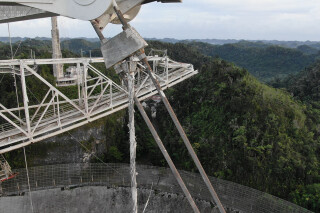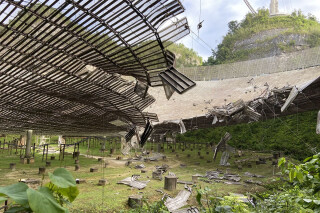An auxiliary cable failed in August, leaving a 30m gash in the dish below. A second cable then failed earlier this month.
The US National Science Foundation is to begin plans to decommission the telescope, which for 57 years has served as a world-class resource for radio astronomy, planetary, solar system and geospace research – as well as the location for movies such as Contact and Goldeneye.
Multiple assessments by independent engineering companies found that the telescope structure is in danger of a catastrophic failure and its cables may no longer be capable of carrying the loads they were designed to support. Furthermore, several assessments stated that any attempts at repairs could put workers in potentially life-threatening danger. Even in the event of repairs going forward, engineers found that the structure would likely present long-term stability issues.
“NSF prioritizes the safety of workers, Arecibo Observatory’s staff and visitors, which makes this decision necessary, although unfortunate,” said NSF director Sethuraman Panchanathan. “For nearly six decades, the Arecibo Observatory has served as a beacon for breakthrough science and what a partnership with a community can look like. While this is a profound change, we will be looking for ways to assist the scientific community and maintain that strong relationship with the people of Puerto Rico.”
Arecibo Observatory’s telescope consists of a radio dish 305m in diameter with a 900-ton instrument platform hanging 137m above. The platform is suspended by cables connected to three towers.

On 10th August, an auxiliary cable failed, slipping from its socket in one of the towers and leaving a 30m gash in the dish below. NSF authorised Arecibo Observatory to take all reasonable steps and use available funds, which amounted to millions of dollars, to secure the analysis and equipment needed to address the situation. Engineers were working to determine how to repair the damage and determine the integrity of the structure when a main cable connected to the same tower broke on 6th November.
The second cable break was unexpected - engineering assessments following the auxiliary cable failure had indicated the structure was stable and the planning process to restore the telescope to operation was under way. Engineers subsequently found the 75mm main cable snapped at about 60% of what should have been its minimum breaking strength during a period of calm weather, raising the possibility of other cables being weaker than expected.
Inspections of the other cables revealed new wire breaks on some of the main cables, which were original to the structure. There was also evidence of significant slippage at several sockets holding the remaining auxiliary cables, which were added during a refit in the 1990s that added weight to the instrument platform.


Thornton Tomasetti, the engineering firm of record hired by the University of Central Florida (UCF) to assess the structure, found that given the likelihood of another cable failing, repair work on the telescope - including mitigation measures to stabilise it for additional work - would be unsafe. Stress tests to capture a more accurate measure of the remaining cables' strength could collapse the structure, Thornton Tomasetti found. The firm recommended a controlled demolition to eliminate the danger of an unexpected collapse.
“Although it saddens us to make this recommendation, we believe the structure should be demolished in a controlled way as soon as pragmatically possible,” said a letter submitted by Thornton Tomasetti. “It is therefore our recommendation to expeditiously plan for decommissioning of the observatory and execute a controlled demolition of the telescope.”
UCF also hired two other engineering firms to provide assessments of the situation – WSP and Wiss, Janney & Elstner Associates. One recommended immediate stabilisation action. The other, after reviewing Thornton Tomasetti's model, concurred that there is no course of action that could safely verify the structure's stability and advised against allowing personnel on the telescope's platforms or towers.
After receiving the contracted assessments, NSF brought in an independent engineering firm and the Army Corps of Engineers to review the findings. The firm NSF hired concurred with the recommendations of Thornton Tomasetti and expressed concern about significant danger from uncontrolled collapse. The Army Corps of Engineers recommended gathering additional photographic evidence of the facility and a complete forensic evaluation of the broken cable.
Given the fact that any stabilisation or repair scenario would require workers to be on or near the telescope structure, the degree of uncertainty about the cables' strength and the extreme forces at work, NSF accepted the recommendation to prepare for controlled decommissioning of the 305m.
“Leadership at Arecibo Observatory and UCF did a commendable job addressing this situation, acting quickly and pursuing every possible option to save this incredible instrument,” said Ralph Gaume, director of NSF's Division of Astronomical Sciences. “Until these assessments came in, our question was not if the observatory should be repaired but how. But in the end, a preponderance of data showed that we simply could not do this safely. And that is a line we cannot cross.”
The aim is to retain as much as possible of the remaining infrastructure of Arecibo Observatory, so that it remains available for future research and educational missions.
NSF has authorised a high-resolution photographic survey using drones, and is considering options for forensic evaluation of the broken cable - if such action could be done safely - to see if any new evidence could inform the ongoing plans.
Got a story? Email news@theconstructionindex.co.uk


